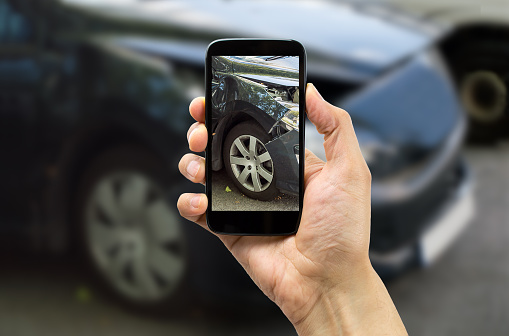Learn how to take photographs that will provide strong evidence for your injury claim.
 In this era of selfies and smartphones, it is practically second nature for most people to immediately take out their phone and snap a photo when something noteworthy happens. It is great that this instinct is leading people to take photos of the scenes of motor vehicle accidents that they may have been involved in or witnessed.
In this era of selfies and smartphones, it is practically second nature for most people to immediately take out their phone and snap a photo when something noteworthy happens. It is great that this instinct is leading people to take photos of the scenes of motor vehicle accidents that they may have been involved in or witnessed.
What is not so great is that these photos are not always as useful as they could be for the purposes of building a strong auto accident injury claim. They may be missing important reference points and details that could help make the difference between an okay case and a very strong one.
Here are some tips that you can follow to make sure any photos you take serve as effective evidence in an injury claim:
Act fast. If it is safe to do so, it is preferable to take your photos before any of the vehicles are moved from the positions they ended up in immediately after the accident. If you are unable to take photos due to an injury, try to get someone else to help you.
Start with wide shots. It is best to start with shots that include the entire scene of the accident and have all the involved vehicles in the frame. This helps establish where all the vehicles were in relation to one another and to the roadway.
Include traffic signs & signals. Many accidents occur at intersections because someone has ignored a stop sign, yield sign, or traffic signal. If you suspect this has happened, be extra sure to photograph these kinds of signs and signals. It can also be helpful to include the street signs in the frame.
Photograph damage to all vehicles. Sometimes people make the mistake of only photographing the damage to their own vehicle. In reality, you need to document all the damage to all vehicles or property because this damage helps tell the story of how the accident occurred, including how fast drivers were going.
Look for evidence in the environment. Tire marks, broken glass, and property damage can also help show how the accident took place, so be sure to look for these kinds of evidence and photograph them in context.
Photograph injuries. Having photographs of your injuries can show how badly you were hurt in the accident and help with your argument for appropriate compensation for pain and suffering.
What to Do With Your Photos
Once you have taken your photos and gotten necessary medical attention, your next step should be to contact an experienced auto accident injury attorney such as Fernando D. Vargas. Attorney Vargas can review your photos and listen to your description of the accident to help you understand your options for pursuing compensation. For a free initial consultation, call us at 909-982-0707 now.




